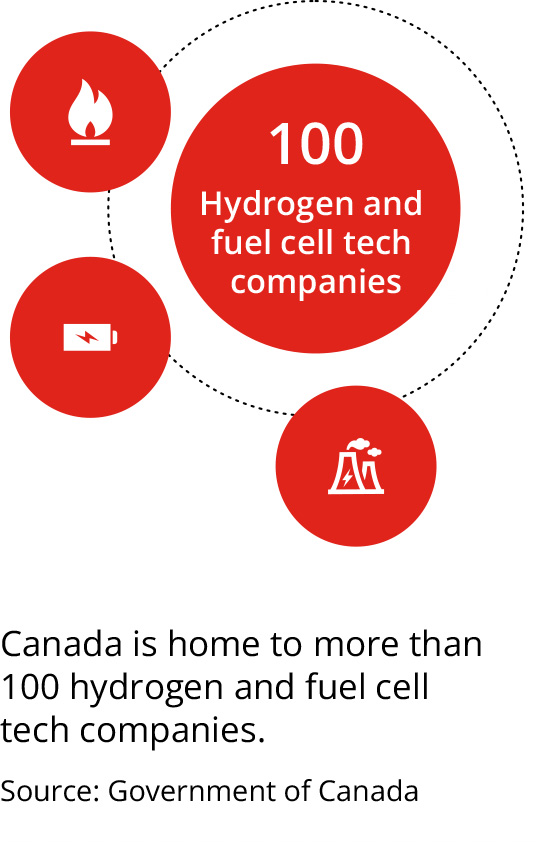Establishing a transformative, clean hydrogen economy represents a once in a generation opportunity for investors in low-cost, emissions-free energy
As the world looks to reach net zero greenhouse gas (GHG) emissions, clean hydrogen has the potential to accelerate innovation and transform energy generation as we know it by making green power available on an industrial scale.
Source: Clean Energy Canada
Hydrogen production in Canada
Source: World Economic Forum
Heavy-duty trucking globally
Vancouver’s Hydra Energy became the first company to deliver a hydrogen-converted, heavy-duty vehicle to a paying fleet customer, Lodgewood Enterprises, in October 2021. Describing itself as the world’s first Hydrogen-as-a-Service (HaaS™) provider, Hydra Energy sources low-carbon hydrogen at a fixed, below-the-cost-of-diesel discount from the Canadian industrial chemical provider Chemtrade. It provides this clean fuel to Hydra-retrofitted fleets, thus paving the way for a more immediate and affordable energy transition.
DECARBONISING HEATING
Clean hydrogen produced from renewable electricity can be used to help decarbonise residential and industrial heating and gas turbines. Currently, heating accounts for 80 per cent of energy used in domestic homes in Canada, and hydrogen can be blended with natural gas as a replacement to decrease emissions.
In January 2022, 3,600 residents in the city of Markham, Ontario, earned their place in history when their homes became the first in North America to benefit from blended gas. Crucially, hydrogen can also be stored in the existing gas distribution system for use at peak times, which helps increase the value of renewable electricity in decarbonisation pathways.
Hydrogen blending is also proceeding at pace in Alberta. In a first-of-its-kind project for the province, the ATCO Group is preparing to deliver a blend of natural gas containing five per cent hydrogen by volume into a subsection of the Fort Saskatchewan natural gas distribution system. Later this year, approximately 2,000 customers will be the first in the province to use hydrogen-blended natural gas that will reduce the GHG intensity of the associated natural gas stream.
Source: Government of Canada
Canada’s potential to abate carbon dioxide equivalent (CO2e) by 2050
LOW-CARBON AMMONIA
Canada’s use of hydrogen in the production of low-carbon ammonia has already begun to attract interest and investment from Europe and Asia, where so-called “blue ammonia” is being adopted as a marine fuel and alternative feedstock for thermal power generation. This is especially the case in Japan, where the government is looking to secure 30mn tonnes of ammonia by 2050 as part of its efforts to achieve net zero emissions.
Quebec’s Project Courant is one of the first companies focused on shipping low-carbon ammonia to Europe. Developed by Montreal’s Hy2Gen Canada Inc, the 500 tonne a day, 200MW hydro-powered green ammonia production facility will become the first of the company’s carbon-free production platforms in North America when it becomes fully operational in 2026.
Hy2gen’s interest in establishing Canadian operations is mirrored by Japanese general trading house Itochu Corporation, which has partnered with Petronas Energy Canada to investigate the feasibility of building a US$1.3bn low-carbon ammonia production facility on the outskirts of Edmonton. Itochu plans to supply Japan’s energy, metal and petrochemical producers with Canadian-produced ammonia from the 1mn-tonne-a-year plant, whose construction is set to begin in 2023.
A recent assessment of the scale and scope of Canada’s clean hydrogen potential described a situation in which the country is well positioned to become a leader in the field.
“It’s time for leaders across public and private sectors to assess the size of the opportunity and how their respective organisations can help enable the hydrogen future,” Lance Mortlock, EY Canada’s energy leader, writes. “Canada has an immediate opportunity to integrate existing energy infrastructure into the evolving hydrogen value chain to become a global leader in hydrogen production, distribution and market use.”
The time is now to invest in hydrogen in Canada.
Learn moreBack to top









